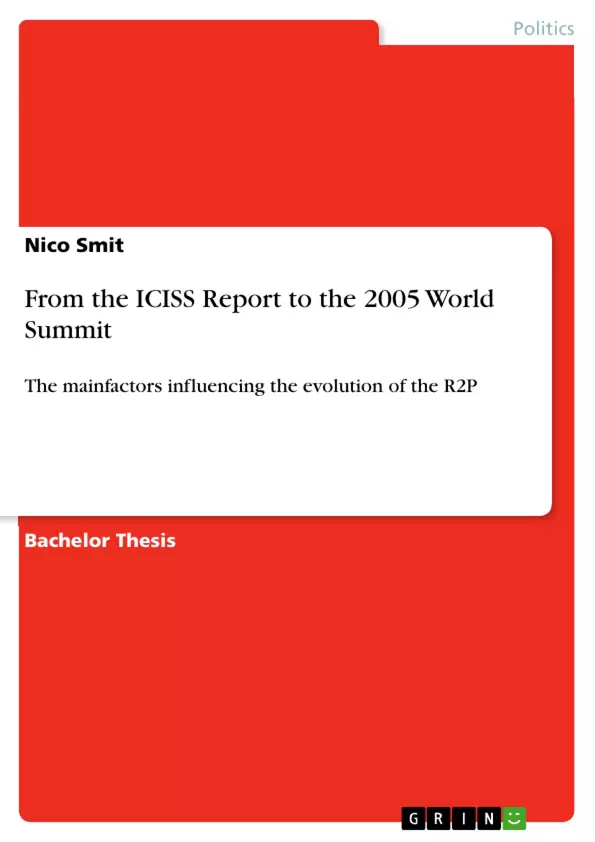A large portion of the literature that deals with the evolution of the R2P focuses on the principle’s progression from the ICISS report to the HLP report, the Secretary-General’s report and ultimately the 2005 World Summit Outcome Document. This thesis provides a discussion of the main events and arguments that have influenced the debate around the R2P and the principle’s evolution, namely, the war on terror and the 2003 war in Iraq, the crisis in Darfur, and lastly, U.N. Security Council buy-in regarding the ICISS articulated criteria to guide the use of military force in humanitarian intervention. The thesis is divided into three sections, the first providing a conceptual background to humanitarian intervention. The second part shifts the discussion to the ICISS and the R2P, and the final section focuses on the main factors that have influenced the principle’s evolution. A central theme underlying the reason for the undertaking of this thesis is the claim that the international system is experiencing a change in the writers/authors of the rules of the system. The argument is built by using the abovementioned main factors influencing the R2P’s evolution as evidence – the central assertion being that the war in Iraq has weakened the moral standing of the U.S. and the U.K., and has negatively impacted on the credibility of these states as norm carriers. This has not only diminished their ability to build consensus on and commitment to the R2P, but has also engendered widespread hostility and suspicion towards the principle. The result is an international endorsement of the R2P that is substantially different from its initial emergence in the ICISS report, which by many accounts lacks much of the substance which would have enabled a decisive response from the international society to situations where such action is needed most.
Inhaltsverzeichnis (Table of Contents)
- Introduction
- Background to Humanitarian Intervention
- Meaning and Definition of Intervention
- The Concept of Humanitarian Intervention
- Humanitarian Intervention and the U.N. Charter
- The ICISS and the Responsibility to Protect
- Past Failures, the U.N. Secretary General's Challenge and the Establishment of the ICISS
- Francis Deng and the Concept of Sovereignty as Responsibility
- The ICISS and Sovereignty as Responsibility
- Core Principles of R2P
- R2P Principles for Military Intervention
- From the ICISS Report to the 2005 World Summit: Main Factors Influencing the Evolution of the R2P
- The 2005 World Summit and R2P
- The War on Terror and the 2003 War in Iraq
- The Crisis in Darfur
- The Problem of Security Council Buy-In
- Conclusion
Zielsetzung und Themenschwerpunkte (Objectives and Key Themes)
The purpose of this paper is to examine the evolution of the Responsibility to Protect (R2P) principle, focusing on the key factors that shaped its development. It examines the historical context of humanitarian intervention, analyzes the ICISS Report, and explores the implications of R2P in the context of international law and the contemporary world.
- The historical context of humanitarian intervention
- The evolution of the R2P principle
- The relationship between sovereignty and responsibility
- The role of international institutions in protecting civilians
- The challenges and controversies surrounding the implementation of R2P
Zusammenfassung der Kapitel (Chapter Summaries)
The introduction delves into the origins of the ICISS Report and its relevance in the context of the 9/11 attacks and the subsequent “War on Terror.” The report aimed to reignite the debate surrounding humanitarian intervention, particularly in the wake of incidents like the Rwandan genocide and the Srebrenica massacre.
Chapter 4 provides a historical context for humanitarian intervention, exploring its definition, evolution, and the legal framework surrounding it. The chapter highlights the challenges of reconciling humanitarian intervention with the principle of state sovereignty, as enshrined in the U.N. Charter.
Chapter 5 examines the formation of the ICISS and its groundbreaking report, “The Responsibility to Protect.” The chapter explores the concept of sovereignty as responsibility, introduced by the ICISS, and how it departs from the traditional view of sovereignty as control. It delves into the core principles of R2P and its implications for military intervention, highlighting the shift in perspective towards a greater emphasis on the protection of civilians.
Chapter 6 investigates the factors that influenced the evolution of R2P from the ICISS Report to the 2005 World Summit. The chapter analyzes the impact of the War on Terror, the 2003 invasion of Iraq, and the crisis in Darfur on the development and implementation of R2P. It also examines the challenges of achieving consensus and securing Security Council support for interventions based on R2P.
Schlüsselwörter (Keywords)
The key terms and concepts explored in this work include: humanitarian intervention, Responsibility to Protect (R2P), sovereignty as responsibility, state sovereignty, international law, just cause, right authority, military intervention, civilian protection, international institutions, U.N. Charter, the ICISS Report, War on Terror, 2003 War in Iraq, Darfur crisis, Security Council buy-in.
- Citar trabajo
- Nico Smit (Autor), 2010, From the ICISS Report to the 2005 World Summit, Múnich, GRIN Verlag, https://www.grin.com/document/210331



